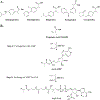Bioactivation and reactivity research advances - 2021 year in review
- PMID: 35876116
- PMCID: PMC10282953
- DOI: 10.1080/03602532.2022.2097254
Bioactivation and reactivity research advances - 2021 year in review
Abstract
This year's review on bioactivation and reactivity began as a part of the annual review on biotransformation and bioactivation led by Cyrus Khojasteh (see references). Increased contributions from experts in the field led to the development of a stand alone edition for the first time this year focused specifically on bioactivation and reactivity. Our objective for this review is to highlight and share articles which we deem influential and significant regarding the development of covalent inhibitors, mechanisms of reactive metabolite formation, enzyme inactivation, and drug safety. Based on the selected articles, we created two sections: (1) reactivity and enzyme inactivation, and (2) bioactivation mechanisms and safety (Table 1). Several biotransformation experts have contributed to this effort from academic and industry settings.[Table: see text].
Conflict of interest statement
Disclosure statement
Klarissa D. Jackson is co-investigator on a study funded by the Genentech Foundation. Jackson received a speaker honorarium from Genentech, Inc. to present research that is not related to this manuscript. No potential conflict of interest was reported by the author(s).
Figures














Similar articles
-
Novel advances in biotransformation and bioactivation research - 2020 year in review.Drug Metab Rev. 2021 Aug;53(3):384-433. doi: 10.1080/03602532.2021.1916028. Epub 2021 Jun 24. Drug Metab Rev. 2021. PMID: 33910427 Free PMC article.
-
Novel advances in biotransformation and bioactivation research-2019 year in review.Drug Metab Rev. 2020 Aug;52(3):333-365. doi: 10.1080/03602532.2020.1772281. Epub 2020 Jul 9. Drug Metab Rev. 2020. PMID: 32645275 Free PMC article. Review.
-
Biotransformation and bioactivation reactions - 2018 literature highlights.Drug Metab Rev. 2019 May;51(2):121-161. doi: 10.1080/03602532.2019.1615937. Epub 2019 Aug 6. Drug Metab Rev. 2019. PMID: 31170851 Review.
-
Biotransformation and bioactivation reactions - 2017 literature highlights *.Drug Metab Rev. 2018 Aug;50(3):221-255. doi: 10.1080/03602532.2018.1473875. Epub 2018 Jun 28. Drug Metab Rev. 2018. PMID: 29954222 Review.
-
Biotransformation and bioactivation reactions - 2016 literature highlights.Drug Metab Rev. 2017 Aug;49(3):285-317. doi: 10.1080/03602532.2017.1326498. Epub 2017 May 31. Drug Metab Rev. 2017. PMID: 28468514 Review.
References
-
- Khojasteh SC, Bumpus NN, Driscoll JP, Miller GP, Mitra K, Rietjens IMCM, Zhang D. 2019. Biotransformation and bioactivation reactions – 2018 literature highlights. Drug Metab Rev. 51(2):121–161. - PubMed
-
- Khojasteh SC, Miller GP, Mitra K, Rietjens IMCM. 2018. Biotransformation and bioactivation reactions – 2017 literature highlights. Drug Metab Rev. 50(3):221–255. - PubMed
-
- Khojasteh SC, Rietjens IMCM, Dalvie D, Miller G. 2017. Biotransformation and bioactivation reactions – 2016 literature highlights. Drug Metab Rev. 49(3):285–317. - PubMed
Publication types
MeSH terms
Grants and funding
LinkOut - more resources
Full Text Sources
